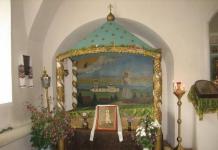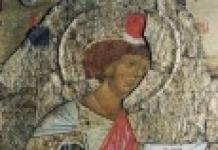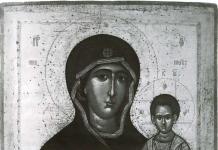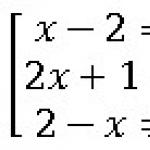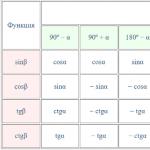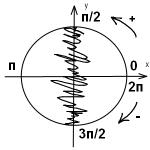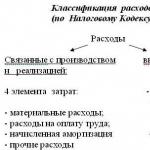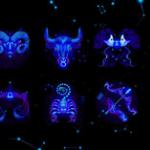The Holy Prophet Daniel and the Three Holy Youths Ananias, Azariah and Misail. 600 years BC Jerusalem was conquered by the king of Babylon; the temple erected by Solomon was destroyed, and many of the people of Israel were taken into captivity.
Among the captives were noble young men Daniel, Ananias, Azariah and Misail. The King of Babylon, Nebuchadnezzar, ordered that they be taught Chaldean wisdom and raised in luxury at his court. But they, keeping the commandments of their faith, refused excesses and led a strict lifestyle; They ate only vegetables and water. The Lord gave them wisdom, and Saint Daniel the gift of insight and interpretation of dreams.
The Holy Prophet Daniel, sacredly preserving faith in the One God and trusting in His all-powerful help, surpassed all the Chaldean astrologers and magi with his wisdom and was brought closer to King Nebuchadnezzar. One day Nebuchadnezzar saw a strange dream that amazed him, but when he woke up, he forgot what he had seen. The Babylonian sages were powerless to find out what the king dreamed. Then the holy prophet Daniel glorified before everyone the power of the true God, who revealed to him not only the content of the dream, but also its prophetic meaning. After this, Daniel was elevated by the king to the rank of commander of Babylon.
Soon, King Nebuchadnezzar ordered the erection of his image - a huge statue to which divine honors were to be given. For refusing to do this, three youths - Ananias, Azariah and Misail - were thrown into a flaming furnace. The flame rose 49 cubits above the furnace, scorching the Chaldeans standing nearby, and the holy youths walked in the midst of the flames, offering prayer to the Lord and chanting Him (). The Angel of the Lord, appearing, cooled the flame, and the youths remained unharmed. The king, seeing this, ordered them to go out and turned to the true God.
Under King Belshazzar, Saint Daniel interpreted the mysterious inscription (“Mene, Takel, Peres”) that appeared on the wall of the palace during a feast, foreshadowing the fall of the Babylonian kingdom.
Under the Persian king Darius, Saint Daniel, at the slander of his enemies, was thrown into a den with hungry lions, but they did not touch him, and he remained unharmed. King Darius rejoiced over Daniel and commanded throughout his kingdom to worship the God of Daniel, “because He is the Living and Ever-Bearing God, and His kingdom is indestructible, and His dominion is endless.”
The Holy Prophet Daniel deeply grieved for his people, who were suffering just punishment for many sins and iniquities, for the transgression of God’s commandments - the heavy captivity of Babylon and the destruction of Jerusalem: “Incline, O my God, Thy ear and hear, open Thy eyes and look at our desolations and to the city upon which Thy Name is named; for we present our supplications before Thee, trusting not in our righteousness, but in Thy great mercy" (). The fate of the people of Israel and the fate of the whole world was revealed to the holy prophet, who atoned for the iniquities of his people with righteous life and prayer.
When interpreting the dream of King Nebuchadnezzar, the prophet Daniel announced successive kingdoms and the greatness of the last Kingdom - the Kingdom of our Lord Jesus Christ (). The prophetic vision of seventy weeks () told the world the signs of the First and Second Comings of the Lord Jesus Christ and related events (). Saint Daniel interceded for his people before Darius' successor, King Cyrus, who highly valued him, and declared freedom to the captives.
Daniel himself and his friends Ananias, Azariah and Misail lived to a ripe old age and died in captivity. According to testimony (June 9), Saints Ananias, Azariah and Misail were beheaded by order of the Persian king Cambyses.
Iconographic original |
|
|
|
Rus. 1502.Prophet Daniel (fragment of an icon of the prophetic series). 1502 62 x 101.5. From the prophetic series of the Ferapontov Monastery. Kirillo-Belozersky Museum (KBIAHMZ). |
|
|
Kirillov. 1497.Prophet Daniel (fragment of an icon of the prophetic series). 1497 67 x 179. From the prophetic series of the Assumption Cathedral of the Kirillo-Belozersky Monastery. Tretyakov Gallery Moscow. |
Byzantium. 1300 - 1320.Prophet Daniel. Icon. Byzantium. 1300 - 1320 years. 41 x 19. Vatopedi Monastery (Athos). |
|
Athos. XIV.Prophet Daniel. Manuel Panselin. Fresco of the Church of the Assumption of the Virgin Mary in Protata. Athos. Beginning of the 14th century |
|
Athos. XV.Prophet Daniel and the three youths. Miniature. Athos (Iversky monastery). End of the 15th century Since 1913 in the Russian Public (now National) Library in St. Petersburg. |
|
Athos. 1546.Prophet Daniel. Theophanes of Crete and Simeon. Fresco of the Church of St. Nicholas. Stavronikita Monastery. Athos. 1546 |
|
|
| |
The Holy Prophet Daniel is the fourth biblical prophet (related to the so-called “great prophets”), a descendant of a noble Jewish family (according to some assumptions, he could also come from a royal family from the tribe of Judah).
The name "Daniel" translated from Hebrew means - God is my judge, or God judged me.
The beginning of a courtly career at the court of Nebuchadnezzar
In the 4th year of the reign of Joachim, during the first conquest of Jerusalem by Nebuchadnezzar (about 606 - 607 BC), Daniel, along with his fellow tribesmen, fell into Babylonian captivity. Then he was 14-17 years old. Together with other noble youths, Daniel was chosen as “fit to serve in the king’s palace...” (Dan. 1:4).

Historical reference
600 years BC. Jerusalem was conquered by the Babylonian king Nebuchadnezzar, the temple erected by Solomon was destroyed, and many of the people of Israel were taken into captivity. Young Daniel was also taken captive and, together with King Joachim of Judah, was taken from Jerusalem to Babylon.

Nebuchadnezzar II
Nebuchadnezzar was an outstanding politician who managed to avoid the mistakes of the Egyptian pharaohs. The latter humiliated the captured Jews, which created the danger of rebellion. Babylon was unable to maintain a despotic regime through military means because there were too many people to keep in line and not enough soldiers to do so. Nebuchadnezzar chose a different way to control conquered peoples: to force people to remain loyal to the empire. Nebuchadnezzar took all the best from each nation and put it into the service of Babylon. Therefore, if anyone wanted to start a rebellion, he would have to direct it against his own people.
The king “commanded that they be brought up for three years...taught them the books and the language of the Chaldeans” (Dan. 1:4-5). Those. in essence, the youths were subjected to an elaborate system of re-education, taught the language and literature of Babylon, as well as mathematics, navigation, politics, history and geography - the whole range of Babylonian learning was implanted in their minds during these three years. Nothing should have distracted them from learning, so “the king appointed them daily food from the king’s table and wine, which he himself drank...” (Dan. 1:5).
After 3 years of re-education, the young men were to appear before the king (Dan. 1:5) for testing. The pupils had to forget that they were Jews, servants of God, and become servants of the king of the earth. They even changed their names, and there was a deep meaning in this.
So, Nebuchadnezzar ordered that handsome Jewish youths be selected from noble families to serve in the palace. Among the chosen ones was Daniel and his three companions - Ananias, Azariah and Mishael. They were raised in the court of this king, but remained faithful to their God (Dan. 1:3-16).
By order of the king, Daniel was renamed Belshazzar, which translated from Chaldean meant “keeper of the hidden treasures of Baal.” Ananias (“God is merciful”) was named Shadrach (the name of the pagan god Marduk). Mishael (“Who is like God”) received the name Meshach (containing an ancient form of the name of the goddess Venus). Azariah (“The Lord is my help”) was renamed Abednego (“servant of the god Nebo”). Thus, names containing in their meaning belonging to God were changed so that they began to refer to pagan gods.
However, with the adoption of pagan names, the young men did not betray the faith of their fathers. Fearing that they would be defiled by pagan food, they begged their teacher to give them food not from the royal table, sprinkled with blood sacrificed to idols, but simple, vegetable food. For their devotion to the true faith, the Lord rewarded the young men with success in science (Dan. 1:17), and the Babylonian king, who was present at the exam, found that they were smarter than his Babylonian sages: “There were none like Daniel, Hananiah, Mishael and Azariah, and they began to serve the king. And in every matter of wise understanding, whatever the king asked them, he found them ten times higher than all the mysticians and magicians who were in his whole kingdom” (Dan. 1:19-20).

The Holy Prophet Daniel and the Three Youths Ananias, Azariah and Misail
Even in his youth, Daniel became especially famous at the court of Nebuchadnezzar for his Divine gifts, in particular, he received from God “the gift of understanding and all kinds of visions and dreams” (Dan. 1:17).
King Nebuchadnezzar's dream and its interpretation
Thus, Daniel explained to King Nebuchadnezzar an extraordinary dream, which greatly troubled the king (Dan. 2:1-49).
Nebuchadnezzar's Dream
In a dream, Nebuchadnezzar saw a huge and terrible image made of four metals: the head was made of gold, the chest and arms were made of silver, the belly and thighs were made of copper, the legs were made of iron, and the feet were made of iron mixed with clay and smeared with it. . A stone rolled down the mountain, smashed the image into dust and itself grew into a large mountain.

King Nebuchadnezzar's Dream of a Golden Image
Daniel explained to the king that the image symbolized the four pagan kingdoms that were to succeed each other, starting with Babylon and ending with Rome. The mysterious stone that crushed the image symbolized the Messiah, and the resulting mountain symbolized His eternal Kingdom (Church): “And in the days of those kingdoms, the God of heaven will erect a kingdom that will never be destroyed, and this kingdom will not be transferred to another people; it will crush and destroy all kingdoms, and itself will stand forever.”(Dan. 2:44).
Daniel interprets Nebuchadnezzar's dream
This dream and its interpretation interest and concern us today as much, or even more, than Nebuchadnezzar. The divine interpretation of this dream, given through Daniel, shows that the head of the Image was the Kingdom of Babylon, the chest and arms were the subsequent Medo-Persian Empire, the belly and thighs of copper were the Greek Empire, and the legs were the Roman Empire. The feet represented the “Holy Roman Empire” and its successors; the iron in the feet represented civil power, and the clay mixed with the iron and covering it illustrated the ecclesiastical power of our day. Apparently, we live in the days of ten fingers, that is, parts of the Image. The stone represents God's Kingdom, which the clay on the idol's feet only imitated. The stone represents God's Chosen Church, gathered from Jews and Gentiles—from every nation and creed—to constitute the Kingdom of the Messiah. Soon this Kingdom will be established in power and great glory, and the kingdoms of this world will disappear as if on cue. Then the Kingdom of the Messiah will grow until it fills the whole earth and brings everything under its control, and every conscious sinner is cut off by the Second Death.

Miracle in the Furnace of Fire
Arrogance clouded Nebuchadnezzar's mind. He decided to erect a huge statue of himself (as the Ruler of the Earth) on the field of Deire. Having created a golden idol, the king ordered all his subjects to bow to it as soon as they heard the sounds of musical instruments, under pain of death by burning. But three friends refused to bow to the golden idol (Marduk), for which, by order of King Nebuchadnezzar, they were thrown into a fiery furnace. But the angel of God kept them unharmed in the fire. Christian tradition believes that the angel who preserved the youths was the Archangel Michael.
The three youths in the fiery furnace are Jewish youths in Babylonian captivity, friends of the prophet Daniel, who were thrown into the fire by King Nebuchadnezzar for refusing to bow to the idol, but were saved by the archangel Michael and came out unharmed.
Nebuchadnezzar looked in amazement at what was happening in the flames and exclaimed: “Didn’t we throw three men into the fire tied up? Behold, I see four unbound men walking in the midst of the fire, and there is no harm to them; and the appearance of the fourth is like the son of God.” After which he ordered the execution to be stopped. When the three youths came out of the oven, the Babylonians were convinced that not only did the fire not burn a hair on their heads, but even their clothes did not smell of fire. After which, amazed at the power of God, who knows how to save those who believe in him, he again exalted these three Jews.
Nebuchadnezzar's second dream
After a little time, Nebuchadnezzar had another dream - he saw a large and strong tree, reaching its height to the sky and which could be seen to the ends of the whole earth, with many fruits, so that everyone could feed from it. But then the Holy One descended from heaven and said that they should cut down this tree, cut off its branches, shake off its leaves and scatter its fruits, but that they should leave its main root in the ground and let it live with the animals in the grass, so that the human heart would be taken away from Him and the heart of a beast will be given to him, and seven times will pass over him. This dream confused the king, but none of the Babylonian fortunetellers and sorcerers could explain to him its meaning until Daniel was called, upon whom the Spirit of God rested.

Daniel will explain to Nebuchadnezzar that his dream predicts punishment for his pride
Saint Daniel explained to Nebuchadnezzar that this dream shows the punishment of Nebuchadnezzar for his pride, that he will soon lose his kingdom, he himself will be excommunicated from people and his dwelling will be with the beasts of the field, he will feed himself grass like an ox, and so seven years will pass until he does not know that the Most High rules over the kingdom of man and gives it to whomever He wants. Soon everything exactly came true: Nebuchadnezzar lost his mind and ate grass like an animal (seven years), after which his reason returned to him and he gave praise to God (Dan; ch. 4).
Mysterious inscription or Belshazzar's last feast
The Prophet Daniel remained in the rank of court dignitary under Nebuchadnezzar and his five successors, and then was an adviser to Darius the Mede and Cyrus the Persian (Dan. 6:28).
After Nebuchadnezzar, his son Belshazzar became king of Babylon. One day he arranged a feast for a thousand of his nobles. To do this, he ordered his servants to bring gold and silver vessels that his father had taken from the Jerusalem Temple. When the vessels taken from the sanctuary of the house of God in Jerusalem were brought, the king, his nobles and their wives began to drink wine from them and praise their gold, silver, copper, iron, wood and stone gods. But suddenly in the royal palace, where the feast was taking place, a mysterious inscription appeared on the wall. The king shouted loudly and ordered the wise men of Babylon to be brought in to explain what was written. He promised to make the third ruler in his kingdom the one who would explain the meaning of incomprehensible words. But none of the Babylonian sages could explain the meaning of the words written on the wall. They brought Daniel and the king asked him to read and explain the meaning of incomprehensible words.

Daniel translates the mysterious writing on the wall to Belshazzar
Daniel told Belshazzar that God was angry with him for his pride and for taking sacred vessels to drink wine from, while glorifying idols. Then he said that it was not written on the wall: “And this is what is written: "MENE, MENE, TEKEL, UPHARSIN" (you are insignificant, and your kingdom will be divided by the Medes and Persians)(Dan. 5:25). This is the meaning of the words: “ME” - God has numbered your kingdom and put an end to it; “TEKEL” - you are weighed on the scales and found very light; “PERES” - your kingdom is divided and given to the Medes and Persians. Then, at the command of Belshazzar, they clothed Daniel in scarlet robe and placed a golden chain around his neck and proclaimed him the third ruler in the kingdom." That same night happened what God had predicted through the words written on the wall of the palace: Belshazzar was killed, and his kingdom Darius the Mede took possession.
According to Jer. Gennady Egorov (“The Holy Scriptures of the Old Testament”, part 2), excerpt Dan. 5:18-31 is of exceptional importance for understanding the entire book of the prophet Daniel. First of all, Daniel uttered historical prophecies about the destinies of kingdoms and the world, so his book can be called a philosophy of history: every government must know the hand of God over itself. Arrogance is not valuable in the sight of God and must be punished. The only kingdom that will stand is the Kingdom of God, and it will be unique and eternal.
All the visions of the prophet Daniel and the dreams interpreted by him boil down, in essence, to one thought: all kingdoms will fall, giving way to the revelation of the Kingdom of Heaven.
Daniel in the lions' den
Under the Persian king Darius, the holy prophet Daniel took a high position for his honesty. Those around him hated him because he refused to take bribes. They did not know how to convict him, except perhaps in his religion. They convinced King Darius to issue a decree stating that if anyone bowed to any other deity other than Darius, he would be thrown into the lions' den. Because of this, they brought charges against Daniel for disobeying the king's religious edict. Thus, according to the slander of his enemies, Daniel was thrown into a den of lions so that the lions would tear him to pieces, but the Lord shut the mouth of the lions and the prophet remained unharmed (Dan. ch. 6, ch. 14: 28-42).
Prophet Daniel in the lions' den
The prophet Habakkuk was informed by an angel about what happened to Daniel. The angel sent Habakkuk to take food and then, lifting him into the air by his hair, carried him into the lions' den. Daniel saw this as a sign that God had not abandoned him. In the morning the king returned and, finding Daniel alive and unharmed, believed in the power of the Jewish God. The courtiers who schemed against Daniel were themselves thrown to the lions, who immediately tore them to pieces (Dan. 6:14-24).
Vision of four beasts representing four kings who will rise from the earth (Dan. 7)
God revealed many things to the prophet Daniel in visions, for example, vision of four beasts representing the four kingdoms(Dan. chapter 7).
According to tradition, as in the case of Nebuchadnezzar's dream, these kingdoms are understood to be Babylon, Persia, Greece and Rome (or Syria).
The little horn with eyes and mouth (Dan. 7:8) - Antiochus Epiphanes (this is in historical terms), who tried to eradicate the Old Testament religion. Antiochus is a prototype of the Antichrist, his persecution is a classic prototype of all subsequent persecutions.
- “saints of the Most High” (Dan. 7:18) – the Maccabees are their descendants
- At the end there is a vision of the eternal Kingdom of the Son (Dan. 7:9-14).
This same prophecy speaks educatively about the Antichrist, his persecution against believers and the duration of his power: “until a time (i.e. a year) and times (two years) and half a time (half a year)” (Dan. 7:25), - in total 3.5 years.
Since ancient times, the vision of the prophet Daniel in chapter 7, along with other Old Testament eschatological prophecies, was widely used by the Church Fathers to formulate the Christian teaching about the end of the world and the Second Coming of Jesus Christ (links to chapter 7 are in Justin the Philosopher, Irenaeus of Lyons, the first detailed interpretation of the book of the prophet Daniel is given by Hippolytus of Rome, St. Ephraim the Syrian has a reference to chapter 7 - “The Word on the Second Coming of the Lord Jesus Christ.” Moreover, most researchers believe that, along with other eschatological teachings of St. Ephraim, this “Word” was the basis of the Byzantine iconography of the Last Judgment.
Vision of the “70 Weeks” (Dan. 9)
A little later, Daniel received revelation of the "70 weeks", which indicates the time of the first coming of the Messiah and the foundation of his Kingdom (Church) ( cm. Dan. 9). Here by weeks we mean seven years (the circle of Jewish holiday years is built on seven-year cycles) that have to pass from the time of the publication of the decree on the construction of the second Jerusalem temple (in 453 BC) until the appearance of Christ and His fulfillment of the New Testament (Dan. 9: 23-27). Therefore, 70 weeks are 490 years.
But the meaning of the explanation given to Daniel by the Archangel Gabriel, from the time of the decree of King Cyrus on the return of the Jews to their homeland from captivity, seven weeks must pass before the creation of the temple, after the next 62 weeks the Anointed One will be killed, the New Testament will be established and the sacrifices will be abolished, and then the abomination of desolation will become in a holy place.
There is complete correspondence between Daniel's prophecy and later history. It is the first seven weeks that fully correspond to the 49 years that elapsed from the decree of Cyrus until the completion of the construction of the city of Jerusalem and the temple. The next 62 weeks are equal to 434 years, which, when combined with the 49 years of the first weeks, are equal to 483 years, and correspond to the period before the appearance of Jesus Christ to serve the human race. According to prophecy, the killing of Christ should take place in the middle of the last week, i.e. three and a half years after the appearance, as indeed happened according to the legend of the Evangelists. After this half-week, the abomination of desolation must come in the holy place, i.e. the destruction of Jerusalem, which in turn, pointing to the words of Daniel, was predicted by the Savior (Matthew 24:15). This is how all this actually happened during the destruction of Jerusalem by Titus and Vespasian.
Vision of the Great War (Dan. 10-12)
Daniel fasts for three weeks and the Man appears to him with revelation. According to St. Hippolytus of Rome, “he sees the Lord Himself...”.
The beginning describes future wars, the victory of Alexander the Great, apparently over the Persian troops (Dan. 11:2).
Then the wars of the Lagids and Seleucids are described (many details are quite accurately predicted).
Vision of the little horn, the new king, who is both a type of Antiochus and Antichrist (Dan. 11:21-23). Antiochus Epiphanes is the worst enemy of the Jews, and this vision signifies the persecution of Antiochus against the Jews and the final destruction of himself. The famous Jewish historian Josephus considers the desecration of the Jerusalem Temple by Antiochus Epiphanes to be the exact fulfillment of Daniel's prophecy: “And they will appoint a portion of the army that will defile the sanctuary of power, and will put an end to the daily sacrifice, and will set up the abomination that makes desolate.”(Dan. 11:31), spoken over 408 years.
Dan. 11:36-37 - the new mystery of the coming lawlessness - this is no longer about Antiochus, who worshiped the gods.
Dan. 9:27, Dan. 11:31 Dan. 12:11 – "abomination of desolation"- Matthew 24:15-16 – Christ quotes the prophet Daniel and then speaks about the sorrow of subsequent times (the last chapters of the book of the prophet Daniel are dedicated to this, and the Apocalypse is about this).
Dan. 12:4,9 – about the seal of the blj. Theodoret argues this way: “Put, he says, on the book of the seal of obscurity and make it not clear to everyone, until knowledge will increase,” and, according to prophecy, “the whole earth will be filled with the knowledge of the Lord, like water covering the sea.”(Isa.11:9). The grace of God’s Spirit, at the coming of the Savior, opened these seals and made the unclear clear for believers.”
Tombs of the Prophet Daniel
The Prophet Daniel died at a very old age (over 90 years old), having been in captivity until his old age, and was buried in a tomb in the city of Susa.

Tomb of the Prophet Daniel (Barry, Iraq)
However, his graves are also shown in Kirkuk (Iraq) and Samarkand (Uzbekistan). The grave in Samarkand is a crypt about 18 meters long. Legend has it that the crypt is constantly growing. The saint is revered by both Christians and Muslims, who call the saint buried there Daniyar. Next to the grave is a 500-year-old pistachio tree, which after several years of dead wood suddenly sprouted green shoots in the 2000s. It is also believed that Tamerlane brought the remains of the saint to Samarkand from a military campaign in Asia Minor.

The grave of the prophet Daniyar is located in the Khoja Donier mausoleum in Samarkand
Daniel is revered by the Christian Church especially for predicting the coming of the Messiah into the world, His appearance in the Temple of Jerusalem. Jews do not consider Daniel a prophet, perhaps because he did not speak to God directly, but only to the Angels.
Book of the Prophet Daniel
The Holy Prophet Daniel left a book of his prophecies, consisting of 14 chapters.
The book of the prophet Daniel is a prophetic book historically associated with the Babylonian captivity. There are practically no prophetic speeches in it, but there are records of the events of the prophet’s life, his visions and their explanations. One of the main features of the book is the symbolic nature of the presentation of prophecies:
The prophet Daniel himself explained dreams and received prophecies in his sleep (Dan. 2:19, Dan. 4:11, Dan. 7:1);
- dreams and symbols were explained to him by an Angel (Dan. 7:16-Dan. 8:15);
- through an Angel he sometimes received symbolic revelations (Dan. 9:24, Dan. 10:11);
- apocalyptic form of revelations (especially in chapters 7-12);
- the grandeur of the symbolism (even more than that of the prophets Ezekiel and Zechariah, for example, in chapter 7).
1) Historical part(chapters 1-6): the life of the prophet Daniel and contemporary events in the Babylonian and Medo-Persian kingdoms, in which he and his friends participated;
2) Prophetic part(Chapters 7-12): visions and revelations about the fate of Judea and the pagan kingdoms that had an influence on the history of the Jews, from the time of the era of captivity to the establishment of the Kingdom of the “saints of the Most High” on earth.
Both parts reveal the same teaching about the universal Kingdom of God and the Son of Man in their triumph over paganism. In its development, this doctrine comes down to two provisions:
A) The world kingdom cannot remain forever in the power of the Gentiles; it exists only for the sake of Israel. Chapters 1-6 of the book are devoted to this topic. Here is their summary: power over the world belongs to God, but His Kingdom will come after a certain time, after the fall of the four world monarchies (chapter 2). Pagan kings can be rulers of the world only if they are conscious of the dependence of their power on the supreme power of God.
B) In the Person of the Son of Man, Israel is destined for dominion over the world, the implementation of the Kingdom of God on earth.
Since pagan kings cannot dominate, power over the world must pass to another people, perhaps Israel, who will become the actual ruler of the world after the fall of the fourth monarchy. Then the Kingdom will be with the “Saints of the Most High” under the headship of the Son of Man, and they will possess it “forever.” By that time their sins will be forgiven (chapter 9).
Daniel(Hebrew, Daniel, ancient Greek, Daniel, Arabic, Daniyal) - biblical prophet (related to the so-called “great prophets”).
A descendant of a noble Jewish family, as a teenager he and his fellow tribesmen were taken into Babylonian captivity after Nebuchadnezzar's conquest of Jerusalem. In Babylon he received a Chaldean education and was called to serve at court. According to the Bible, Daniel had the gift from God to understand and interpret dreams, for which he became famous at the court of Nebuchadnezzar, and after the fall of Babylon - at the court of Cyrus and Darius. Famous episodes in Daniel's story include his miraculous escape from the lions' den and the interpretation of the words "mene, mene, tekel, upharsin" inscribed by a mysterious hand on the wall during Belshazzar's feast.
At the same time, the author of the Book of Daniel demonstrates rather vague knowledge about the realities of the Neo-Babylonian kingdom, and his prophecies were considered as later by the Neoplatonist Porphyry in the 3rd century. There is now a broad scholarly consensus around the assertion that the Book of Daniel was created significantly after the Babylonian captivity (possibly in Palestine during the time of Antiochus IV Epiphanes and the Maccabees c. 170-164 BC), representing an example that emerged in the Hellenistic era apocalyptic literature, and there is no reliable evidence for the existence of the prophet himself.
In the Old Testament, the name Daniel is mentioned several more times, including in the address of the book of the prophet Ezekiel to the king of Tyre: “you are wiser than Daniel” (28:3). During excavations in the city of Ugarit, a poem from the 14th century BC was discovered. e., the main character of which - a wise and fair judge who stood up for widows and orphans - bears the name Dani-Il, referring to his veneration of the god El/Il.
Bible Book of Daniel
Five Kings of Daniel and their interpretation
Daniel explained to Nebuchadnezzar a dream about an image (Dan. 2:31), broken by a stone that fell from a mountain (the image is the pagan kingdoms that succeed each other, the stone is the Messiah, and the mountain is the Eternal Kingdom of God) (see Colossus with Feet of Clay).
According to Ephraim the Syrian, the golden head is the kingdom of Babylon. Silver chest and arms - the kingdom of the Medes. The belly and thighs are copper - the kingdom of the Persians. Iron shins - the kingdom of Alexander the Great. Legs of iron and clay - ten kings who rebelled after Alexander. Another smaller kingdom, that is, the kingdom of the Medes, will rise up and destroy the kingdom of Babylon. The kingdom of Cyrus, king of Persia, will prevail over the entire earth. Toes made of iron and clay - ten kings who rebelled in the kingdom of Greece, some of whom are strong and strong like iron, while others are small and powerless. And although they will enter into alliances with each other, they will not have unanimity and love;
John Chrysostom adds that the words “they will be mixed through the seed of men” (Dan. 2:43) mean that among these kings many will not be of the royal family.
“And in the days of those kingdoms, the God of Heaven will erect a kingdom that will never be destroyed, and this kingdom will not be transferred to another people” (Dan. 2:45) - according to the interpretation of Ephraim the Syrian: “This kingdom will not be given to the Jewish people. Although it was mysteriously ordained in the Maccabees, who humiliated the kingdom of the Greeks; but in reality this prophecy was fulfilled in our Lord.” “The stone was not cut out of the mountain with hands” (Dan. 2:45) - this is our Lord, Who was born in humiliation and, like a stone, was cut off from the mountain, that is, descended from the tribe of Abraham. Ephraim also writes that the Mountain also means “the Holy Virgin, from whom a stone was cut off without hands, that is, without artifice.”
(17)December 30, Orthodox Christians honor the memory of Saint Daniel and the martyrs Ananias, Azariah and Misail.
600 years BC. Jerusalem was conquered by the Babylonian king Nebuchadnezzar, the temple erected by Solomon was destroyed, and many of the people of Israel were taken into captivity. Young Daniel was also taken captive and, together with King Joachim of Judah, was taken from Jerusalem to Babylon. Nebuchadnezzar was an outstanding politician who managed to avoid the mistakes of the Egyptian pharaohs. The latter humiliated the captured Jews, which created the danger of rebellion. Babylon was unable to maintain a despotic regime through military means because there were too many people to keep in line and not enough soldiers to do so. Nebuchadnezzar chose a different way to control conquered peoples: to force people to remain loyal to the empire. Nebuchadnezzar took all the best from each nation and put it into the service of Babylon. Therefore, if anyone wanted to start a rebellion, he would have to direct it against his own people.
Many people were captured, among whom were 4 young men from noble families: Daniel, Ananias, Azarius and Misail. King Nebuchadnezzar liked them and were included in his retinue. The king “commanded that they be brought up for three years...taught them the books and the language of the Chaldeans” (Dan. 1:4-5). Those. in essence, the youths were subjected to an elaborate system of re-education, taught the language and literature of Babylon, as well as mathematics, navigation, politics, history and geography - the whole range of Babylonian learning was implanted in their minds during these three years. Nothing should have distracted them from learning, so “the king appointed them daily food from the king’s table and wine, which he himself drank...” (Dan. 1:5).
After 3 years of re-education, the young men were to appear before the king (Dan. 1:5) for testing. The pupils had to forget that they were Jews, servants of God, and become servants of the king of the earth. They even changed their names, and there was a deep meaning in this. By order of the king, Daniel was renamed Belshazzar, which translated from Chaldean meant “keeper of the hidden treasures of Baal.” Ananias (“God is merciful”) was named Shadrach (the name of the pagan god Marduk). Mishael (“Who is like God”) received the name Meshach (containing an ancient form of the name of the goddess Venus). Azariah (“The Lord is my help”) was renamed Abednego (“servant of the god Nebo”). Thus, names containing in their meaning belonging to God were changed so that they began to refer to pagan gods.
However, with the adoption of pagan names, the young men did not betray the faith of their fathers. Fearing that they would be defiled by pagan food, they begged their teacher to give them food not from the royal table, sprinkled with blood sacrificed to idols, but simple, vegetable food. For their devotion to the true faith, the Lord rewarded the young men with success in science (Dan. 1:17), and the Babylonian king, who was present at the exam, found that they were smarter than his Babylonian sages: “there were none like Daniel, Ananias, Mishael and Azariah, and they became serve the king. And in every matter of wise understanding, whatever the king asked them, he found them ten times higher than all the mysticians and magicians who were in his whole kingdom” (Dan. 1:19-20).
For their godly lifestyle, the Lord rewarded them with wisdom, and Daniel also received the gift of interpreting dreams and insight. When the king had a dream, it was he who was able to interpret it and talk about its meaning. In a dream, Nebuchadnezzar saw a huge and terrible image made of four metals: the head was made of gold, the chest and arms were made of silver, the belly and thighs were made of copper, the legs were made of iron, and the feet were made of iron mixed with clay and smeared with it. . A stone rolled down the mountain, smashed the image into dust and itself grew into a large mountain.
Daniel explained to the king that the image symbolized the four pagan kingdoms that were to succeed each other, starting with Babylon and ending with Rome. The mysterious stone that crushed the image symbolized the Messiah, and the resulting mountain symbolized His eternal Kingdom (Church): “And in the days of those kingdoms, the God of heaven will erect a kingdom that will never be destroyed, and this kingdom will not be transferred to another people; it will crush and destroy all kingdoms, but it will stand forever” (Dan. 2:44).
This dream and its interpretation interest and concern us today as much, or even more, than Nebuchadnezzar. The divine interpretation of this dream, given through Daniel, shows that the head of the Image was the Kingdom of Babylon, the chest and arms were the subsequent Medo-Persian Empire, the belly and thighs of copper were the Greek Empire, and the legs were the Roman Empire.
The feet represented the “Holy Roman Empire” and its successors; the iron in the feet represented civil power, and the clay mixed with the iron and covering it illustrated the ecclesiastical power of our day. Apparently, we live in the days of ten fingers, that is, parts of the Image. The stone represents God's Kingdom, which the clay on the idol's feet only imitated. The stone represents God's Chosen Church, gathered from Jews and Gentiles—from every nation and creed—to constitute the Kingdom of the Messiah. Soon this Kingdom will be established in power and great glory, and the kingdoms of this world will disappear as if on cue. Then the Kingdom of the Messiah will grow until it fills the whole earth and brings everything under its control, and every conscious sinner is cut off by the Second Death.
Miracle in the Furnace of Fire
Arrogance clouded Nebuchadnezzar's mind. He decided to erect a huge statue of himself (as the Ruler of the Earth) on the field of Deire. Having created a golden idol, the king ordered all his subjects to bow to it as soon as they heard the sounds of musical instruments, under pain of death by burning. But three friends refused to bow to the golden idol (Marduk), for which, by order of King Nebuchadnezzar, they were thrown into a fiery furnace. But the angel of God kept them unharmed in the fire. Christian tradition believes that the angel who preserved the youths was the Archangel Michael.
Nebuchadnezzar, amazed at what was happening in the flames, exclaimed: “Didn’t we throw three men into the fire bound? Behold, I see four unbound men walking in the midst of the fire, and there is no harm to them; and the appearance of the fourth is like the son of God.” After which he ordered the execution to be stopped. When the three youths came out of the oven, the Babylonians were convinced that not only did the fire not burn a hair on their heads, but even their clothes did not smell of fire. After which, amazed at the power of God, who knows how to save those who believe in him, he again exalted these three Jews.
Nebuchadnezzar's second dream
After a little time, Nebuchadnezzar had another dream - he saw a large and strong tree, reaching its height to the sky and which could be seen to the ends of the whole earth, with many fruits, so that everyone could feed from it. But then the Holy One descended from heaven and said that they should cut down this tree, cut off its branches, shake off its leaves and scatter its fruits, but that they should leave its main root in the ground and let it live with the animals in the grass, so that the human heart would be taken away from Him and the heart of a beast will be given to him, and seven times will pass over him. This dream confused the king, but none of the Babylonian fortunetellers and sorcerers could explain to him its meaning until Daniel was called, upon whom the Spirit of God rested.
Saint Daniel explained to Nebuchadnezzar that this dream shows the punishment of Nebuchadnezzar for his pride, that he will soon lose his kingdom, he himself will be excommunicated from people and his dwelling will be with the beasts of the field, he will feed himself grass like an ox, and so seven years will pass until he does not know that the Most High rules over the kingdom of man and gives it to whomever He wants. Soon everything exactly came true: Nebuchadnezzar lost his mind and ate grass like an animal (seven years), after which his reason returned to him and he gave praise to God (Dan; ch. 4).
Mysterious inscription or Belshazzar's last feast
The Prophet Daniel remained in the rank of court dignitary under Nebuchadnezzar and his five successors, and then was an adviser to Darius the Mede and Cyrus the Persian (Dan. 6:28).
After Nebuchadnezzar, his son Belshazzar became king of Babylon. One day he arranged a feast for a thousand of his nobles. To do this, he ordered his servants to bring gold and silver vessels that his father had taken from the Jerusalem Temple. When the vessels taken from the sanctuary of the house of God in Jerusalem were brought, the king, his nobles and their wives began to drink wine from them and praise their gold, silver, copper, iron, wood and stone gods. But suddenly in the royal palace, where the feast was taking place, a mysterious inscription appeared on the wall. The king shouted loudly and ordered the wise men of Babylon to be brought in to explain what was written. He promised to make the third ruler in his kingdom the one who would explain the meaning of incomprehensible words. But none of the Babylonian sages could explain the meaning of the words written on the wall. They brought Daniel and the king asked him to read and explain the meaning of incomprehensible words.
Daniel told Belshazzar that God was angry with him for his pride and for taking sacred vessels to drink wine from, while glorifying idols. Then he said that it was not written on the wall: “And this is what is written: “MENE, MENE, TEKEL, UPHARSIN” (you are insignificant, and your kingdom will be divided by the Medes and Persians) (Dan. 5:25). This is the meaning of the words: “ME” - God has numbered your kingdom and put an end to it; “TEKEL” - you are weighed on the scales and found very light; “PERES” - your kingdom is divided and given to the Medes and Persians. Then, at the command of Belshazzar, they clothed Daniel in purple and placed a golden chain around his neck and proclaimed him the third ruler in the kingdom.” That same night happened what God had predicted through the words written on the wall of the palace: Belshazzar was killed, and Darius the Mede took possession of his kingdom.
According to Jer. Gennady Egorov (“The Holy Scriptures of the Old Testament”, part 2), excerpt Dan. 5:18-31 is of exceptional importance for understanding the entire book of the prophet Daniel. First of all, Daniel uttered historical prophecies about the destinies of kingdoms and the world, so his book can be called a philosophy of history: every government must know the hand of God over itself. Arrogance is not valuable in the sight of God and must be punished. The only kingdom that will stand is the Kingdom of God, and it will be unique and eternal.
All the visions of the prophet Daniel and the dreams he interprets boil down, in essence, to one thought: all kingdoms will fall, giving way to the revelation of the Kingdom of Heaven.
Daniel in the lions' den
Under the Persian king Darius, the holy prophet Daniel took a high position for his honesty. Those around him hated him because he refused to take bribes. They did not know how to convict him, except perhaps in his religion. They convinced King Darius to issue a decree stating that if anyone bowed to any other deity other than Darius, he would be thrown into the lions' den. Because of this, they brought charges against Daniel for disobeying the king's religious edict. Thus, according to the slander of his enemies, Daniel was thrown into a den of lions so that the lions would tear him to pieces, but the Lord shut the mouth of the lions and the prophet remained unharmed (Dan. ch. 6, ch. 14: 28-42).
The prophet Habakkuk was informed by an angel about what happened to Daniel. The angel sent Habakkuk to take food and then, lifting him into the air by his hair, carried him into the lions' den. Daniel saw this as a sign that God had not abandoned him. In the morning the king returned and, finding Daniel alive and unharmed, believed in the power of the Jewish God. The courtiers who schemed against Daniel were themselves thrown to the lions, who immediately tore them to pieces (Dan. 6:14-24).
God revealed many things to the prophet Daniel in visions, for example, the vision of four beasts personifying the four kingdoms (Dan. chapter 7).
According to tradition, as in the case of Nebuchadnezzar's dream, these kingdoms are understood to be Babylon, Persia, Greece and Rome (or Syria).
The little horn with eyes and mouth (Dan. 7:8) - Antiochus Epiphanes (this is in historical terms), who tried to eradicate the Old Testament religion. Antiochus is a prototype of the Antichrist, his persecution is a classic prototype of all subsequent persecutions.
- “saints of the Most High” (Dan. 7:18) – the Maccabees are their descendants
- At the end there is a vision of the eternal Kingdom of the Son (Dan. 7:9-14).
This same prophecy speaks educatively about the Antichrist, his persecution against believers and the duration of his power: “until a time (i.e. a year) and times (two years) and half a time (half a year)” (Dan. 7:25), - in total 3.5 years.
Since ancient times, the vision of the prophet Daniel in chapter 7, along with other Old Testament eschatological prophecies, was widely used by the Church Fathers to formulate the Christian teaching about the end of the world and the Second Coming of Jesus Christ (links to chapter 7 are in Justin the Philosopher, Irenaeus of Lyons, the first detailed interpretation of the book of the prophet Daniel is given by Hippolytus of Rome, St. Ephraim the Syrian has a reference to chapter 7 - “The Word on the Second Coming of the Lord Jesus Christ.” Moreover, most researchers believe that, along with other eschatological teachings of St. Ephraim, this “Word” was the basis of the Byzantine iconography of the Last Judgment.
Vision of the “70 Weeks” (Dan. 9)
A short time later, Daniel received the revelation of the “70 Weeks,” which indicated the time of the first coming of the Messiah and the establishment of his Kingdom (Church) (see Dan. 9). Here, by weeks we mean seven years (the circle of Jewish holidays is built on seven-year cycles), which have to pass from the time of the publication of the decree on the construction of the second Jerusalem temple (in 453 BC) until the appearance of Christ and His fulfillment of the New Testament (Dan. 9 :23-27). Therefore, 70 weeks are 490 years.
But the meaning of the explanation given to Daniel by the Archangel Gabriel, from the time of the decree of King Cyrus on the return of the Jews to their homeland from captivity, seven weeks must pass before the creation of the temple, after the next 62 weeks the Anointed One will be killed, the New Testament will be established and the sacrifices will be abolished, and then the abomination of desolation will become in a holy place.
There is complete correspondence between Daniel's prophecy and later history. It is the first seven weeks that fully correspond to the 49 years that elapsed from the decree of Cyrus until the completion of the construction of the city of Jerusalem and the temple. The next 62 weeks are equal to 434 years, which, when combined with the 49 years of the first weeks, are equal to 483 years, and correspond to the period before the appearance of Jesus Christ to serve the human race. According to prophecy, the killing of Christ should take place in the middle of the last week, i.e. three and a half years after the appearance, as indeed happened according to the legend of the Evangelists. After this half-week, the abomination of desolation must come in the holy place, i.e. the destruction of Jerusalem, which in turn, pointing to the words of Daniel, was predicted by the Savior (Matthew 24:15). This is how all this actually happened during the destruction of Jerusalem by Titus and Vespasian.
Vision of the Great War (Dan. 10-12)
Daniel fasts for three weeks and the Man appears to him with revelation. According to St. Hippolytus of Rome, “he sees the Lord Himself...”.
The beginning describes future wars, the victory of Alexander the Great, apparently over the Persian troops (Dan. 11:2).
Then the wars of the Lagids and Seleucids are described (many details are quite accurately predicted).
Vision of the little horn, the new king, who is both a type of Antiochus and Antichrist (Dan. 11:21-23). Antiochus Epiphanes is the worst enemy of the Jews, and this vision signifies the persecution of Antiochus against the Jews and the final destruction of himself. The famous Jewish historian Josephus considers the desecration of the Jerusalem Temple by Antiochus Epiphanes as an exact fulfillment of the prophecy of Daniel: “And they will appoint a part of the army that will defile the sanctuary of power, and stop the daily sacrifice, and set up the abomination of desolation” (Dan. 11:31), pronounced in 408 years.
Dan. 11:36-37 - the new mystery of the coming lawlessness - this is no longer about Antiochus, who worshiped the gods.
Dan. 9:27, Dan. 11:31 Dan. 12:11 - “the abomination of desolation” - Matthew 24:15-16 - Christ quotes the prophet Daniel and then speaks of the sorrow of subsequent times (the last chapters of the book of the prophet Daniel are dedicated to this, and the Apocalypse is about this).
Dan. 12:4,9 – about the seal of the blj. Theodoret reasons as follows: “Put, he says, on the book of the seal of obscurity and make it not clear to everyone, until knowledge will increase,” and, according to prophecy, “the whole earth will be filled with the knowledge of the Lord, like water covering the sea” (Is. 11:9 ). The grace of God’s Spirit, at the coming of the Savior, opened these seals and made the unclear clear for believers.”
Tombs of the Prophet Daniel
The Prophet Daniel died at a very old age (over 90 years old), having been in captivity until his old age, and was buried in a tomb in the city of Susa.
However, his graves are also shown in Kirkuk (Iraq) and Samarkand (Uzbekistan). The grave in Samarkand is a crypt about 18 meters long. Legend has it that the crypt is constantly growing. The saint is revered by both Christians and Muslims, who call the saint buried there Daniyar. Next to the grave is a 500-year-old pistachio tree, which after several years of dead wood suddenly sprouted green shoots in the 2000s. It is also believed that Tamerlane brought the remains of the saint to Samarkand from a military campaign in Asia Minor.
Book of the Prophet Daniel
The Holy Prophet Daniel left a book of his prophecies, consisting of 14 chapters.
The book of the prophet Daniel is a prophetic book historically associated with the Babylonian captivity. There are practically no prophetic speeches in it, but there are records of the events of the prophet’s life, his visions and their explanations. One of the main features of the book is the symbolic nature of the presentation of prophecies:
The prophet Daniel himself explained dreams and received prophecies in his sleep (Dan. 2:19, Dan. 4:11, Dan. 7:1);
- dreams and symbols were explained to him by an Angel (Dan. 7:16-Dan. 8:15);
- through an Angel he sometimes received symbolic revelations (Dan. 9:24, Dan. 10:11);
- apocalyptic form of revelations (especially in chapters 7-12);
- the grandeur of the symbolism (even more than that of the prophets Ezekiel and Zechariah, for example, in chapter 7).
1) Historical part (chapters 1-6): the life of the prophet Daniel and contemporary events in the Babylonian and Medo-Persian kingdoms, in which he and his friends participated;
2) Prophetic part (chapters 7-12): visions and revelations about the fate of Judea and the pagan kingdoms that had an influence on the history of the Jews, from the time of the era of captivity to the establishment of the Kingdom of the “saints of the Most High” on earth.
Both parts reveal the same teaching about the universal Kingdom of God and the Son of Man in their triumph over paganism. In its development, this doctrine comes down to two provisions:
A) The world kingdom cannot remain forever in the power of the Gentiles; it exists only for the sake of Israel. Chapters 1-6 of the book are devoted to this topic. Here is their summary: power over the world belongs to God, but His Kingdom will come after a certain time, after the fall of the four world monarchies (chapter 2). Pagan kings can be rulers of the world only if they are conscious of the dependence of their power on the supreme power of God.
B) In the Person of the Son of Man, Israel is destined for dominion over the world, the implementation of the Kingdom of God on earth.
Since pagan kings cannot dominate, power over the world must pass to another people, perhaps Israel, who will become the actual ruler of the world after the fall of the fourth monarchy. Then the Kingdom will be with the “Saints of the Most High” under the headship of the Son of Man, and they will possess it “forever.” By that time their sins will be forgiven (chapter 9).
The universal kingdom will include all those “who are written in the book” (Dan. 12:1). The dead will also be resurrected: sinners “to everlasting reproach and shame” (Dan. 12:2), and the righteous “to eternal life... and the wise will shine like the lights in the firmament, and those who turn many to righteousness like the stars, forever and ever.” (Dan. 12:2-3).
On this day, December 30, unmarried girls devote themselves to fortune telling. In order to see your future spouse, you need to take 3 bay leaves and write on them the names of 3 holy youths - Ananias, Azarias and Misail. Then put them under your pillow and go to bed. The betrothed should appear in a dream.
Also traditionally, on this national holiday, theatrical performances are staged about the life story of the three youths and Daniel.
If on Danilov's day frost covered everything around, then after 7 days warming will occur.
If there is a snowstorm outside the window, then the bees will work well next year.
He came from a noble family. During the conquest of Jerusalem by Nebuchadnezzar in 606 BC. Fifteen-year-old Daniel, along with other Jews, was captured in Babylon. There he and other most capable young men were sent to school to prepare for service at the royal court.
Three of his friends studied with Daniel: Ananias, Misail Azariah. For several years they studied the local language and various Chaldean sciences. Upon entering school, these three young men were given new names: Shadrach, Meshach and Abednego. However, with the adoption of pagan names, the young men did not betray the faith of their fathers. Fearing that they would be defiled by pagan food, they begged their teacher to give them food not from the royal table, sprinkled with the blood of animals sacrificed to idols, but simple, vegetable food. The teacher agreed, on the condition that after ten days of eating plant foods, he would check their health and well-being.
At the end of the trial period, these young men turned out to be healthier than others who ate meat from the royal table, and the teacher allowed them to eat food at their own discretion. For their devotion to the true faith, the Lord rewarded the young men with success in the sciences, and the Babylonian king, who was present at the exam, found that they were smarter than even his Babylonian sages.
After graduating from school, Daniel and three friends were assigned to serve at the royal court and remained in the rank of court dignitary throughout the reign of Nebuchadnezzar and his five successors. After the conquest of Babylon, he became an adviser to the kings Darius of Media and Cyrus of Persia.
God gave Daniel the ability to understand the meaning of visions and dreams, and he demonstrated this ability by interpreting two of Nebuchadnezzar's dreams that greatly confused the king.
In one of his dreams, Nebuchadnezzar saw a huge and terrible idol made of four metals. A stone that rolled down the mountain smashed the image into dust, and it itself grew into a large mountain. Daniel explained to the king that the image symbolized the four pagan kingdoms - from Babylon to Rome - which were supposed to succeed each other. The mysterious stone that crushed the idol symbolized the Messiah, and the resulting mountain symbolized His eternal Kingdom on earth (the Church of Christ).
In his book (which is part of the Bible), the prophet Daniel talks about the feat of his three friends who refused to bow to the golden idol (Marduk), for which, by order of King Nebuchadnezzar, they were thrown into a fiery furnace. But the angel of God kept them unharmed in the fire.
Details about the activities of the prophet Daniel during the seven years of the reign of Nebuchadnezzar's three successors have not been preserved. In the first year of the reign of Belshazzar, the son of Nebuchadnezzar in this post, the prophet Daniel had a vision of the four kingdoms, after which he saw God in the form of the “Ancient of Days” and the “Son of Man” coming to him, i.e. Lord Jesus Christ.
In his book, Daniel recorded several prophetic visions relating to the end of the world and the second coming of Jesus Christ. In its content, his book has much in common with the Revelation of St. John the Theologian (Apocalypse), which concludes the Bible.
Under Daniel, during the reign of Belshazzar, the Median king Darius conquered Babylon (539 BC), and then Belshazzar also died. Daniel’s prediction came true, explaining the meaning of the inscription on the wall made by a mysterious hand: “Mene tekel upharsin” (you are insignificant, and your kingdom will be divided by the Medes and Persians).
Under Darius of Media, Daniel occupied an important government post. Jealous of Daniel, the pagan nobles slandered him before Darius and ensured that Daniel was thrown to the lions. But God kept his prophet unharmed. Having understood the matter, Darius ordered the slanderers of Daniel to be subjected to the same execution, and the lions instantly tore them to pieces. Soon Daniel received the revelation of the seventy weeks, which indicated the time of the first coming of the Messiah and the founding of his Church.
During the reign of Cyrus, Daniel remained in the same court rank. Not without his participation, in 536, King Cyrus issued a decree on the release of Jews from captivity. According to legend, the prophet Daniel showed Cyrus a prediction about him in the book of the prophet Isaiah, who lived two hundred years earlier.
Struck by the prophecy, the king recognized the power of Jehovah over himself and ordered the Jews to build a temple in his honor in Jerusalem. Under the same king, Daniel was again saved from death, which threatened him for killing the dragon, deified by the pagans.
In the third year of the reign of Cyrus in Babylon, Daniel was honored to receive a revelation about the further fate of the people of God and the four pagan empires. Daniel's predictions about persecution of faith refer to the persecution of Antiochus Epiphanes and at the same time to the coming of the Antichrist. Nothing is known about the subsequent fate of the prophet Daniel, except that he died in old age. His prophetic book consists of 14 chapters. The Lord Jesus Christ twice referred to the prophecies of Daniel in his conversations with the Jews.
The burial places of Saint Daniel were Babylon itself and the city of Susa (currently the city of Shuster). It is believed that Timur transported part of Daniel's remains, namely his hand, to Samarkand. A beautiful mausoleum was built over the burial site, which was rebuilt at the beginning of the 20th century. Next to the mausoleum there is a water source with incredibly tasty water, which is holy. Anyone who wants to go to the mausoleum must drink this water and wash the exposed areas of the body. The place itself simply captivates with its peace and beauty, especially in the warm season, when there is a lot of greenery, and swans swim along the Siab River a few meters from the source.
The place has long been an object of pilgrimage for both local residents and travelers from all over the world. In 1996, Patriarch of Moscow and All Rus' Alexy II, who arrived in Samarkand, visited the mausoleum and consecrated it. They say that after this, near the mausoleum, the pistachio tree, which was considered dry, began to bloom again. Local residents have a belief: if you make wishes and tie a ribbon on this tree, they will definitely come true.
An interesting fact: many pilgrims who come to this place, holy for orthodox religions, use Zoroastrian traditions - they pray to the remains of the saint and tie rags to the trees growing nearby.



